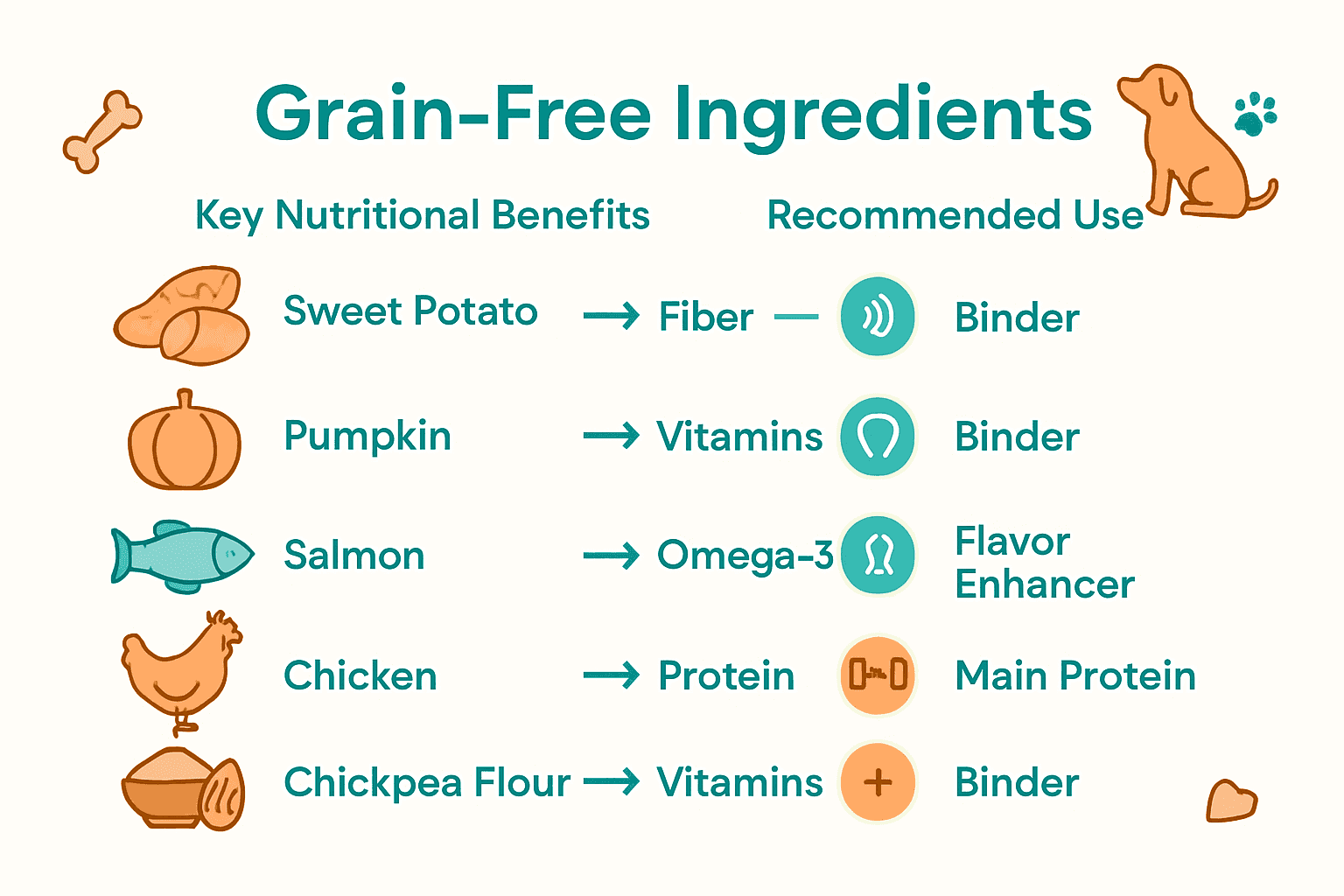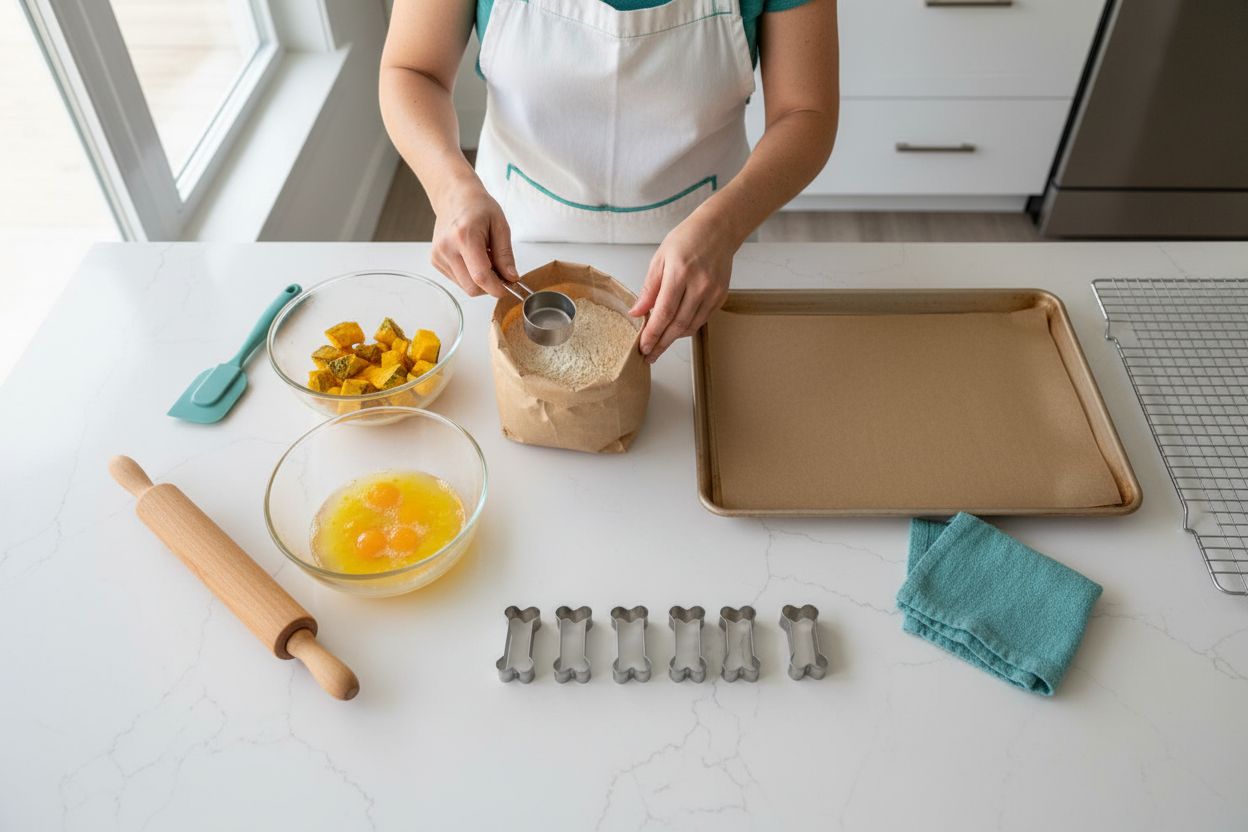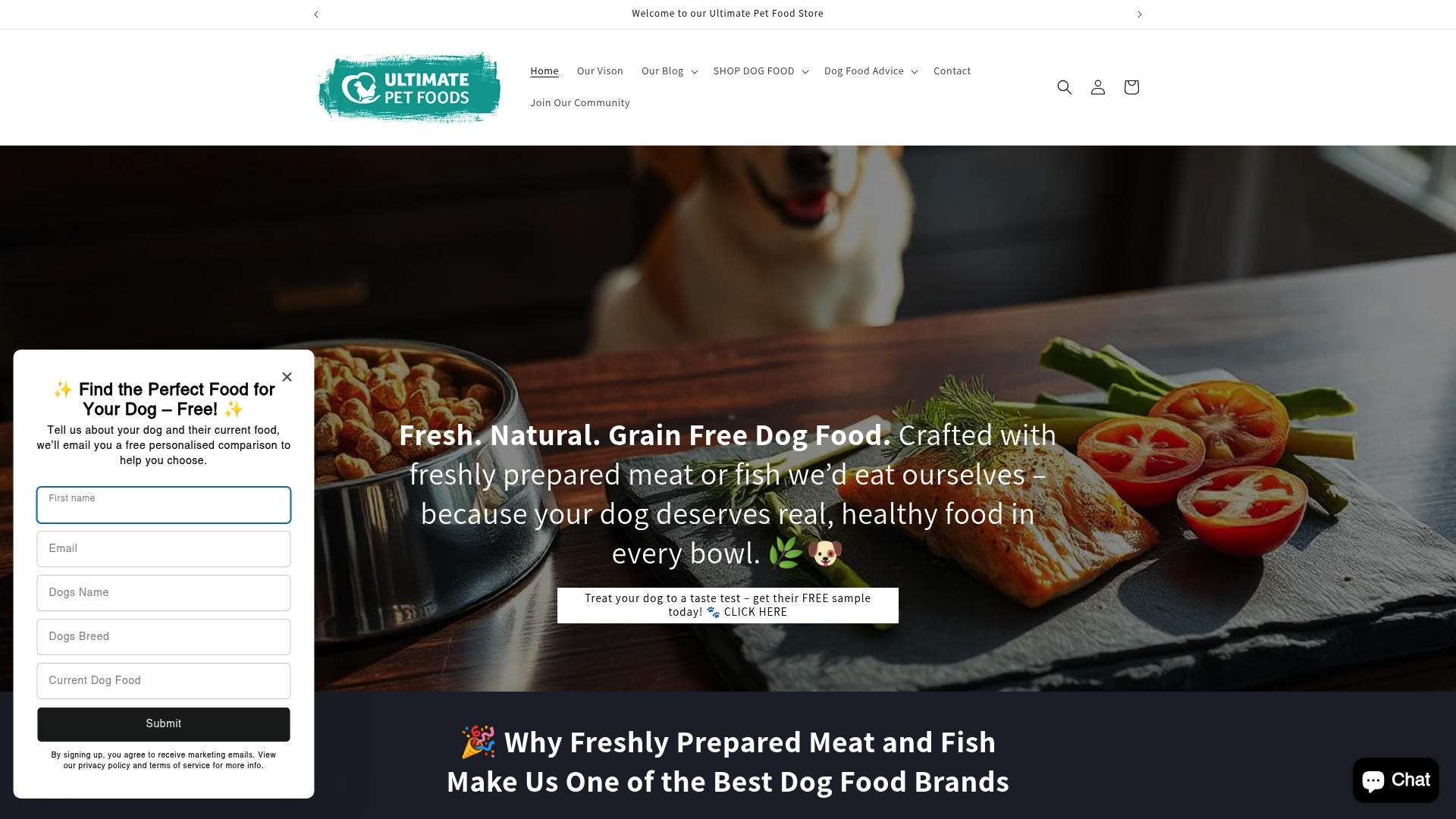
Easy Dog Treat Recipes for Healthy, Grain-Free Snacks
Share
Did you know that over 60 percent of pet owners are searching for healthier treat alternatives for their dogs? Choosing grain-free, homemade treats is the first step to supporting better digestion and energy for your furry companion. With simple ingredients and smart preparation, you can create tasty, nutrient-packed snacks that keep tails wagging with every bite.
Table of Contents
- Step 1: Select Nutritious, Grain-Free Ingredients
- Step 2: Prepare Tools and Baking Space
- Step 3: Mix and Shape Dog Treat Dough
- Step 4: Bake Treats to the Perfect Texture
- Step 5: Check Treats for Quality and Safety
- Step 6: Store and Serve Homemade Dog Treats
Quick Summary
| Key Point | Explanation |
|---|---|
| 1. Choose high-quality grain-free ingredients | Opt for lean proteins like chicken and alternatives like chickpea or almond flour for nutritious dog treats. |
| 2. Sanitize your baking area | Ensure your workspace is clean and organized to prevent contamination during treat preparation. |
| 3. Mix dough to the right consistency | Achieve a dough that is firm yet moist, allowing it to hold its shape without being overly sticky. |
| 4. Bake treats at appropriate temperatures | Adjust baking temperatures to achieve desired textures; lower for chewy, higher for crunchy treats. |
| 5. Store treats in airtight containers | Use airtight containers to keep treats fresh, with options for room temperature, refrigeration, or freezing depending on moisture content. |
Step 1: Select nutritious, grain-free ingredients
Choosing the right grain-free ingredients is the foundation of creating healthy, delicious dog treats that support your furry friend’s wellbeing. According to research from Understanding Natural Dog Food Ingredients for Healthier Pets, selecting high-quality proteins and nutrient-dense alternatives to grains can significantly improve your dog’s diet.
Start by focusing on protein-rich options like lean chicken, beef liver, and novel proteins. These ingredients provide essential amino acids and help maintain muscle health. Chickpea and almond flour serve as excellent grain-free substitutes that offer both structure and nutritional value to your homemade treats.
Consider incorporating nutrient-packed ingredients such as:
Here is a comparison of common grain-free ingredients and their key nutritional benefits:
| Ingredient | Nutritional Benefit | Additional Notes |
|---|---|---|
| Sweet Potato | High in fibre, vitamins A&C | Supports digestive health |
| Pumpkin | Rich in fibre, vitamin E | Aids digestion, low in calories |
| Salmon | Omega-3 fatty acids | Promotes skin & coat health |
| Chicken | High-quality protein | Maintains muscle strength |
| Beef Liver | Iron, vitamin A | Highly palatable for dogs |
| Chickpea Flour | Protein, fibre | Grain-free binder |
| Almond Flour | Vitamin E, healthy fats | Gluten-free, energy source |
| Coconut Flour | Protein, low carbohydrates | Good for sensitive stomachs |
- Sweet potato (rich in vitamins and fiber)
- Pumpkin (supports digestive health)
- Salmon (provides omega-3 fatty acids)
- Coconut flour (high in protein, low in carbohydrates)
Pro Tip: Always choose fresh, high-quality ingredients and avoid any foods toxic to dogs like onions, chocolate, or artificial preservatives.
As you select your ingredients, remember that variety is key. Different proteins and vegetables will provide a range of nutrients that support your dog’s overall health and keep treat time exciting and nutritionally balanced.

Step 2: Prepare tools and baking space
Before diving into dog treat creation, setting up a clean and organised workspace is crucial for ensuring tasty and safe homemade snacks. According to storage hygiene guidance, maintaining a pristine preparation area prevents potential contamination and supports treat quality.
First, gather all necessary equipment. You will need mixing bowls, measuring cups, a reliable baking sheet, parchment paper, wire cooling racks, and silicone spatulas. Select tools that are easy to clean and specifically designated for pet treat preparation to avoid cross-contamination with human food items.
Prepare your workspace by:
- Clearing and thoroughly sanitising countertops
- Washing all tools with hot soapy water
- Drying equipment completely with clean towels
- Laying out ingredients in organised groups
Pro Tip: Dedicate a specific set of baking tools exclusively for dog treats to maintain the highest standards of food safety.
Ensure your baking sheet is lined with parchment paper for easy treat removal and minimal cleanup. Wire cooling racks will be essential for allowing treats to cool evenly and prevent moisture buildup. With your workspace ready, you are now prepared to transform those nutritious ingredients into delicious, healthy dog treats that will make your furry friend’s tail wag with excitement.

Step 3: Mix and shape dog treat dough
With your ingredients and workspace ready, it is time to transform your carefully selected components into delicious dog treats. According to Wholesome Dog Friendly Recipes for Happy Pups, creating the perfect dough requires a systematic and thoughtful approach.
Begin by combining your dry ingredients in a large mixing bowl. Gradually add wet ingredients, stirring consistently to create a uniform mixture. If your recipe includes protein-rich ingredients like chicken or salmon, ensure they are finely chopped or processed to integrate smoothly into the dough.
When mixing your dough, aim for a consistency that is:
- Firm enough to hold shape
- Moist enough to bind ingredients
- Not too sticky or crumbly
Pro Tip: Use a food processor for even mixing and to prevent ingredient clumping.
Once mixed, roll the dough to approximately quarter-inch thickness on a clean surface dusted with grain-free flour. Use cookie cutters or a knife to create fun shapes that will delight your furry friend. Remember that smaller treats cook more evenly and are easier for dogs to enjoy.
With your treats shaped and ready, you are now prepared for the next exciting stage of baking these nutritious, homemade delights.
Step 4: Bake treats to the perfect texture
Now comes the moment of transformation where your carefully prepared dough becomes delectable dog treats. According to research from Why Digestive Health Starts with the Right Dog Food, achieving the ideal texture is crucial for both palatability and nutritional absorption.
Preheat your oven to the specific temperature recommended by your recipe typically between 150 to 180 degrees Celsius. Different ingredients require unique baking approaches. For instance, protein-rich treats like chicken might need lower temperatures to preserve nutrients, while denser treats can withstand slightly higher heat.
Consider these texture guidelines:
- Chewy treats: Lower temperature, longer baking time
- Crunchy treats: Higher temperature, shorter baking time
- Dehydrated treats: Very low temperature over extended periods
Pro Tip: Use parchment paper to prevent sticking and ensure even baking.
Watch your treats closely during baking. Most grain-free dog treats require approximately 20 to 25 minutes of baking time. The edges should turn slightly golden, and the treats should feel firm to the touch. Allow them to cool completely on a wire rack to develop the perfect texture that will make your furry friend’s tail wag with excitement.
Once cooled, your homemade grain-free treats are ready to be stored and enjoyed by your beloved canine companion.
Step 5: Check treats for quality and safety
Congratulations on creating homemade dog treats! Before serving these delicious morsels to your furry friend, a thorough quality and safety check is essential. According to Master Dog Food Portion Control for Optimal Nutrition, responsible pet nutrition goes beyond just preparing food.
First, inspect the treats for visual cues of quality. Look for consistent colour, uniform texture, and absence of any unusual spots or discolouration. Properly baked treats should feel firm and dry to the touch, without any signs of moisture or stickiness that could indicate potential bacterial growth.
Key safety checks include:
- Verifying no burnt or overly dark edges
- Ensuring treats are completely cooled
- Checking for any signs of mould or unusual odours
- Confirming no toxic ingredients were accidentally included
Pro Tip: Treats should comprise no more than 10 percent of your dog’s daily calorie intake to maintain a balanced diet.
Carefully break a treat in half to examine its interior. A high-quality homemade treat should have a consistent texture throughout with no raw or undercooked sections. When in doubt, always err on the side of caution and discard treats that seem questionable.
With these safety checks complete, you are ready to reward your canine companion with nutritious, delicious homemade treats crafted with love and care.
Step 6: Store and serve homemade dog treats
You have successfully created delicious homemade dog treats. Now comes the crucial stage of proper storage and serving. When exploring storage methods, Dog Treats Healthy & Natural with Functional Benefits offers insights into maintaining treat quality and freshness.
Choose an airtight container with a secure lid to prevent moisture and potential bacterial growth. Glass or ceramic containers work best, providing an excellent seal and preventing treats from becoming stale. For refrigeration, ensure treats are completely cool and dry before transferring them to a sealed container.
Storage options include:
- Refrigerator storage for up to two weeks
- Freezer storage for three to six months
- Room temperature storage for treats with low moisture content
Pro Tip: Label your container with the preparation date to track freshness and avoid serving expired treats.
When serving treats, break them into appropriate sizes based on your dog’s breed and size. Small dogs require smaller portions while larger breeds can handle bigger pieces. Always monitor your dog during treat time and introduce new homemade treats gradually to ensure no adverse reactions.
With careful storage and mindful serving, your homemade grain-free treats will provide a nutritious and delightful reward for your beloved canine companion.
Nourish Your Dog with Healthy, Grain-Free Treats and Premium Food Options
Crafting homemade, grain-free dog treats is a wonderful way to show your furry friend how much you care while ensuring they receive wholesome nutrition that supports digestive health and vibrant coats. However, balancing the right ingredients and maintaining quality can sometimes feel challenging. If you want to complement your homemade creations, explore a variety of grain-free and omega-rich dog foods specially formulated to benefit your dog’s health at every stage of life.

Discover how easy it is to provide your dog with delicious, nutritious snacks alongside our premium pet food collections. Visit Ultimate Pet Foods today and find carefully selected blends including options tailored for senior dogs (Blends for our Senior Dogs) plus our full range of natural, hypoallergenic products (collections). Take the next step now to enrich your dog’s diet and happiness with quality you can trust.
Frequently Asked Questions
What ingredients can I use for healthy, grain-free dog treats?
You can use nutritious options like sweet potatoes, pumpkin, salmon, chicken, chickpea flour, and almond flour. Start by selecting a protein source and a grain-free alternative to create a balanced treat recipe.
How do I ensure my homemade dog treats are safe for my pet?
Inspect your treats for consistent color, uniform texture, and absence of unusual spots after baking. Always verify that no burnt edges or moisture remain, ensuring all treats are cool and dry before serving to your dog.
What is the best way to store homemade dog treats?
Store your treats in an airtight container to maintain freshness and prevent bacterial growth. Opt for refrigeration for up to two weeks, or freeze them for three to six months if you plan to keep them longer.
How can I tell if my dog treats are baked to the correct texture?
High-quality dog treats should feel firm to the touch and have slightly golden edges. Bake the treats for 20 to 25 minutes, monitoring them closely to achieve the desired chewiness or crunchiness, depending on your recipe.
Can I customize the dog treat recipe for my dog’s dietary needs?
Yes, you can tailor the ingredients based on your dog’s preferences and any dietary restrictions. For example, if your dog is allergic to certain proteins or grains, substitute them with alternatives that suit their needs while still keeping the treats grain-free.
What’s the ideal size for dog treats based on my pet’s size?
Treat sizes should be adjusted based on your dog’s breed and size. Smaller dogs can enjoy treats the size of a quarter, while larger breeds can have treats that are roughly the size of a small cookie.
Recommended
- Understanding Can Dogs Eat Grains: Nutrition Explained – Ultimate Pet Foods
- Understanding the Benefits of Grain Free Diet for Dogs – Ultimate Pet Foods
- Wholesome Dog Friendly Recipes for Happy Pups – Ultimate Pet Foods
- Grain Free Tuna Dog Food | Freshly Prepared | – Ultimate Pet Foods
- 10 Creative Vegan Gluten Free Snack Ideas for Everyone – PopCornaa
